David Alfaro Siqueiros

(1896 - 1974)
David Alfaro Siqueiros at Artprice. To look at auction records, find Siqueiros's works in upcoming auctions, check price levels and indexes for his works, read his biography and view his signature, access the Artprice database.
Spanish Civil War
In 1936, he was visited in New York by some Spanish friends who informed him of the revolutionary conflict brewing in their homeland. Without further ado, Siqueiros handed his studio over to his North American students, packed his bags and departed for Europe. He arrived in Valencia in January 1937, six months after the outbreak of the Spanish Civil War.
After giving one lecture on the revolutionary importance of art, the painter departed the relatively safe Republican-controlled regions and enlisted in the Fifth Regiment, a part of the International Brigades that fought in the Civil War. Commanded by the Italian communist and Comintern member Vittorio Vidali, who went by the nickname of "Carlos Contreras", it espoused a very hardline Stalinist ideology. Siqueiros saw action on his very first day at the lines, was restored to his Mexican Civil War rank of Captain, immediately promoted further to Major and became an aide to Enrique Lister, Vidali's second-in-command. With time, he was placed in command of the 82nd Brigade, consisting of Spanish anarchists, and by the Spring of 1937, he had been promoted to Lieutenant Colonel and was additionally in charge of the 46th Motorized Brigade, called "the Phantom Brigade" for its speed and efficiency. While Siqueiros was in Spain, his father died, back in Mexico.
In March 1937, Angelica arrived in Spain as a news reporter. Though Siqueiros instructed her to stay away from the front, she tracked down his unit and visited him there. A short time later, they were married in a military ceremony conducted by Enrique Lister. Their different duties -- his as military officer, hers as reporter -- would keep them apart for much of the war.
In November, Angelica received news that her mother had fallen ill. Siqueiros. meanwhile, was ordered to return to Mexico to acquire artillery and airplane optics for the Republican forces. The two traveled home together. While waiting on the equipment to arrive, the soldier-painter set about petitioning the Mexican government to expel Trotsky, to whom they had granted asylum. President Cardenas, though on very cordial terms with Siqueiros, turned a deaf ear to this request.
 Returning
to Spain in the beginning of 1938 with the optics, he was enlisted by the
Spanish
Military Intelligence Service (SIM) for a spying mission into Italy, where
it was hoped his Mexican citizenship would help allay suspicion. He was
successful, and soon back in Spain. For him and the other international
brigadiers, however, the war was almost over. In September 1938, the Spanish
Republicans signed an agreement with the Nationalists to expel the foreign
troops in their ranks, though the Nationalists never kept their side of
the bargain. Siqueiros, as the highest-ranking Mexican officer, was tasked
with gathering up his countrymen and overseeing their withdrawal.
Returning
to Spain in the beginning of 1938 with the optics, he was enlisted by the
Spanish
Military Intelligence Service (SIM) for a spying mission into Italy, where
it was hoped his Mexican citizenship would help allay suspicion. He was
successful, and soon back in Spain. For him and the other international
brigadiers, however, the war was almost over. In September 1938, the Spanish
Republicans signed an agreement with the Nationalists to expel the foreign
troops in their ranks, though the Nationalists never kept their side of
the bargain. Siqueiros, as the highest-ranking Mexican officer, was tasked
with gathering up his countrymen and overseeing their withdrawal.
Back in Mexico, Siqueiros campaigned for the Cardenas government to allow Spanish refugees into the country, again bringing him into conflict with the authorities. After a long hiatus, he returned to painting, producing numerous easel works -- the Echo of the Scream (1937) and the Sob (1939) are two of the most notable, perhaps -- and, of course, murals. His major work from this period is the Portrait of the Bourgeoise (1939), painted for the Electricians' Union, again confirming his reputation as a master muralist.
Trotsky Assasination
In Spain, Siqueiros had worked closely with members of the Comintern (Коминтерн, Russian abbreviation of Communist International), the USSR-sponsored militant revolutionary organization, which advocated the use of any means deemed expedient, including terror tactics and assassination, for achieving its goal of overthrowing capitalist society and replacing it with Soviet-style communism; some of them were his direct superiors. Though never a formal member himself, the painter agreed with the organization's politics and, at least to some degree, its methods. When Trotsky, a sworn enemy of the Comintern's Soviet leadership, was given refuge in Mexico, Siqueiros, among other Mexican communists, vowed to remove him from the country -- one way or another.
After his numerous petitions to Cardenas failed to get Trotsky's visa revoked and only strengthened the Mexican government's resolve to guard their dangerous guest, Siqueiros decided the only solution was an assault on the heavily-guarded Trotsky residence. For this purpose, he brought together some 25 men, including artists working under him, associates from his unionizing days and old comrades-in-arms. Though he later claimed to be acting on his own agenda, it is almost beyond doubt that the Comintern played a hand in supplying him with money, supplies and manpower.
On the night of May 23-24th, 1940, Siqueiros and his men made their move. Overpowering the police guard posted around the exterior of the house, they gained access to the building via a traitor among Trotsky's bodyguards. Once inside, the would-be assassins opened indiscriminate fire with automatic firearms. In his bedroom, Trotsky and his wife Natalya hid behind their heavy bed as the house around them was riddled with bullets. Fortunately for them, the attackers were worried about the arrival of police reinforcements -- the commotion and gunfire could hardly be missed by anyone -- and did not bother to make sure their target was dead.
Suspicion fell on Siqueiros almost immediately. Several of his associates were arrested and pointed to him as the leader of the conspiracy. In the United States, where Siqueiros had previously been regarded as a nuisance rather than any sort of real danger, government agencies went wild, collecting any available information on the communist artist. The painter did not bother waiting for Mexico's law enforcement to take action and fled into the Jalisco countryside where he had contacts and sympathizers from his days of trade union activities. A veritable army of police officers and soldiers was raised for the manhunt. The painter was finally apprehended, with little incident, some four months later.
At the trial, Siqueiros maintained that his intention had never been to assassinate Trotsky, but merely to cause a provocation that would get him expelled from the country, and, in part due to his standing with the contemporary government of Mexico, in part to a more pro-Soviet shift of government ideology, he was cleared of the charge of attempted homicide and released on bail. With trials for trespassing, breaking-and-entering and property damage still pending, the new Mexican president Avila Camacho arranged to have Siqueiros expelled from the country. The painter was given a Chilean visa and airline tickets, and was boarding a plane shortly after his release, together with Angelica Arenal and her daughter Adriana.
Their airfare was paid until Panama, leading Siqueiros to suspect a plot to hand him over to the United States, which was firmly established in that country. Acting decisively, the artist cancelled his flight and instead bought tickets to Bogota, Colombia. There, before the startled authorities could take action, he rented a car and took the overland route for Ecuador. This was a move that no one had expected and Siqueiros effectively
| Tweet |
Siqueiros in the Wilderness
The Mexican family had no problem crossing the Ecuadoran border -- remote, mountainous, poorly guarded and little-travelled -- but beautiful. Though they had neither Colombian nor Ecuadoran visas, the border guards were bemused to find foreigners so far from the regular routes and let them pass. Via Ecuador and Peru, Siqueiros and Angelica eventually arrived in Chile, their original destination, where they caused another stir: the Chilean government had rescinded the painter's visa almost as soon as it had issued it, so the painter was now in the country illegally. Avila Camacho, however, was not overjoyed at the prospect of Siqueiros returning so soon, and high-level diplomacy to resolve the conflict followed. In the end, the painter was allowed to stay and even given a wall to paint, on condition that he would not leave the provincial town of Chillan.
 The
area had been struck by earthquake earlier that year and a great rebuilding
effort was underway. Siqueiros was asked to paint a mural on the interior
of a new school hall. The result was Death
to the Invader (1942), showing the struggle of Mexico's and
Chile's indigenous peoples against European conquerors. The acclaim received
by this mural, one of Siqueiros' masterpieces, finally convinced the Chilean
government to allow him freedom of movement.
The
area had been struck by earthquake earlier that year and a great rebuilding
effort was underway. Siqueiros was asked to paint a mural on the interior
of a new school hall. The result was Death
to the Invader (1942), showing the struggle of Mexico's and
Chile's indigenous peoples against European conquerors. The acclaim received
by this mural, one of Siqueiros' masterpieces, finally convinced the Chilean
government to allow him freedom of movement.
Meanwhile, the United States had finally become embroiled in the Second World War after the treacherous Japanese attack on Pearl Harbor, and Siqueiros, due to his staunchly anti-fascist stance, became a temporary, though unlikely, ally. He was paid to go on a tour of South America preaching a message of anti-Fascism. However, all the painter's attempts to be allowed into the United States, where he had invitations for both exhibitions and mural commissions, were blocked by the State Department.
Instead, Siqueiros traveled to Cuba (then within the US sphere of influence), where, in order to fix his dire financial situation, he painted two murals for private parties: New Day of the Democracies (1943; now in the National Museum of Cuba) and Allegory of Equality and Fraternity of the White and Black Races in Cuba (1943). The latter work unfavorably shocked its owner, the wife of one of Cuba's wealthiest industrialists, and was taken down not long after its completion.
Return to Mexico
In 1943, Siqueiros managed to secure a guarantee from the Mexican authorities that he would not be prosecuted upon his return to the country since, though he had been aided in his flight by the president himself, he had jumped bail to do so. He returned to Mexico City in the end of that year.
Siqueiros and Angelica settled in a large house owned by his mother-in-law. For several months, Siqueiros kept a low profile, avoiding friends and newspaper reporters, and painting in quiet seclusion. However, as it became apparent that no retribution for his earlier flight was forthcoming, he made ready to re-enter the Mexican art scene with his usual flair. In the 40s, the Mexican Mural Movement had stagnated, for lack of funding and general interest; Siqueiros intended to re-vitalize it.
 In
the months that he had spent away from public view, he painted the mural
Cuauhtemoc
Against the Myth (1944) on the interior of his mother-in-law's
house. This, he unveiled that summer. Though the initial reaction of many
critics was that Siqueiros was behind the times and that Muralism was dead
and buried, the painter was unfazed. With vitriolic attacks on "French
formalism" -- the label that he gave all European continental art -- and
enthusiastic editorials, Siqueiros whipped up support for the faltering
Mural Movement. Soon, he had two new mural commissions: New
Democracy (1944), to be painted in the Palace of Fine Arts
in Mexico City, and Patricians and the
Killers of Patricians (Patricios y Patricidas, only
completed in 1968, amid endless obstructions, bureaucratic and otherwise),
to be painted in Mexico City's old customs-house, the "ex Aduana". In 1947,
the artist had a solo exhibition at the Palace of Fine Arts, his first
in Mexico in some 15 years, where he showed El
Coronelazo (1945, a self-portrait), Our
Present Image (Nuestra Imagen Actual, 1947), Cain
in the United States (1947) and the Devil
in the Church (1947), among others.
In
the months that he had spent away from public view, he painted the mural
Cuauhtemoc
Against the Myth (1944) on the interior of his mother-in-law's
house. This, he unveiled that summer. Though the initial reaction of many
critics was that Siqueiros was behind the times and that Muralism was dead
and buried, the painter was unfazed. With vitriolic attacks on "French
formalism" -- the label that he gave all European continental art -- and
enthusiastic editorials, Siqueiros whipped up support for the faltering
Mural Movement. Soon, he had two new mural commissions: New
Democracy (1944), to be painted in the Palace of Fine Arts
in Mexico City, and Patricians and the
Killers of Patricians (Patricios y Patricidas, only
completed in 1968, amid endless obstructions, bureaucratic and otherwise),
to be painted in Mexico City's old customs-house, the "ex Aduana". In 1947,
the artist had a solo exhibition at the Palace of Fine Arts, his first
in Mexico in some 15 years, where he showed El
Coronelazo (1945, a self-portrait), Our
Present Image (Nuestra Imagen Actual, 1947), Cain
in the United States (1947) and the Devil
in the Church (1947), among others.
During this time, the painter also resumed his political activities, re-joining the Mexican Communist Party, participating in rallies, writing articles and engaging in polemics. Soon, he was again arousing the ire of conservative elements in society -- not to mention the US intelligence agencies that had been keeping a close watch on him ever since the ill-fated attack on Trotsky. The brief camaraderie that the West had experienced with the Soviet Union during the Second World War was rapidly coming to an end, to be replaced by the Cold War. Siqueiros would feel the repercussions of this later. For now, however, he was in favor with the government.
1950 marked an important breakthrough for the painter: at the Venice Bienniale, the first at which the work of the Mexican Muralists had been represented, he won second place, narrowly losing the first place to Henri Matisse. This was a profound, if pleasant shock for the artist, who had believed that Mexican art would never be recognized in "European Formalist" circles. That year, he received two new mural commissions in the Palace of Fine Arts, the products of which were Cuauhtemoc Reborn (1951) and The Torture of Cuauhtemoc (1951).
With the Cold War beginning to escalate, the new Communist cause celebre became an effort to stop the Korean War, which was termed a "manifestation of Western imperialism" that "went contrary to the wishes of the Korean people." Siqueiros, of course, was a spear-head of this movement in Mexico. In the Spring of 1951, he organized an exhibition entitled the Salon of May, after the substantially more famous Salon of Paris. Its political theme was a condemnation of war, and it was geared mainly towards lower-class people. Numerous artists were represented. Siqueiros unveiled one of his most famous and outspoken paintings: The Good Neighbor or How Truman Helps the Mexican People (1951).
In all, the 1950s became the painter's most productive decade, part of an overall surge in mural commissions throughout Mexico. In 1952, Siqueiros became involved in decorating the buildings of the new National Autonomous University of Mexico. He put forward the idea that muralists and architects collaborate on the project to create a "perfect synthesis" of art and design. Though his ideas were rejected out of hand, he was given several large walls to paint that would occupy him for a large portion of the next few years. Some of the products of this were: Man, the Master of the Machine, and Not the Slave (1952); From the People to the University -- From the University to the People (1956); New University Emblem (never finished).
Some others of his most notable works of the 1950s include the murals Velocity (1953) on the Chrysler Corporation building, For a Complete Social Security of All Mexicans (1955) in the Hospital de la Raza, and Defense of the Future Victory of Medical Science over Cancer (1958). He also painted an important series of easel works called the Streets of Mexico, which focused on the lower classes.
With increased interest in Mexican Art among Europeans, the painter made several tours abroad, reading lectures in France, Italy, the Netherlands, as well as Eastern bloc countries like Poland and Czechoslovakia. In 1952, he had an exhibition at the Paris Museum of Modern Art. This was marred by protests from, ironically, French Communists, who were angry over Siqueiros' participation in the attacks on Trotsky. In 1956, the painter visited China and India, where he was welcomed by top government figures: Zhou En Lai and Jawaharlal Nehru, respectively. Upon being shown the monumental art of the Hindus and Buddhists, the painter reportedly quipped: "Unless Socialist art can come up with something to equal this, I swear, I will have to become a Buddhist!"
1958 was a year of political turmoil in Mexico. Amid labor unrest, Adolfo Lopez Mateos became Mexico's new president through the government's method of imposing its candidates, and he took a hardline stance against trade unions. Bringing in the army, he dispersed protest marches and demonstrations and authorized mass arrests. Soon, several thousand protesters -- largely railroad workers -- were being held in prison without formal charges or trial.
Siqueiros naturally took a stance against the government -- and suffered for it. Funding for his murals was cut, both by the government and private parties, who wanted to distance themselves from his dangerous ideas. Used to suffering setbacks in his artistic career for the benefit of his political one, the painter paid no heed. In 1959, he founded the Committee for the Freedom of Political Prisoners and Defense of Democratic Liberties. The last straw, however, was when Siqueiros toured Venezuela and the newly-Communist Cuba with a series of political speeches, attracting international attention to the actions of the Lopez Mateos government.
The painter returned to Mexico to discover that a smear campaign had been unrolled against him in the government-controlled press. He received death threats. On March 31, 1960, he was arrested by the Special Security Police, though released a few hours later with a stern warning to stop his activism. Siqueiros refused to be intimidated. Then, on the day of August 9th, as the painter and Angelica were heading home for lunch, they realized they were being followed. Angelica, who was driving, sped away through the narrow streets of Mexico city and managed to lose their tail. They headed for the Cuban embassy, where Siqueiros hoped he would have the ambassador's protection. It was Sunday, however, and the embassy was closed to all business. Telling Angelica to go home, the painter took a cab to the house of his friend Dr. Carrillo Gil. It seemed, however, that this was being watched. Police agents arrived and knocked on the door. They presented no warrant and, overpowering both the homeowner and his guest, dragged Siqueiros off to the police station.
For the next several days, the painter was kept in solitary confinement and subject to several rounds of intimidating interrogation. Publicly, the police denied having him in custody. Siqueiros' fame and high profile, however, meant that this could not be kept up for long and, a week later, the artist was moved to a regular prison with the other political prisoners. The government had little to formally charge Siqueiros with -- incarceration served to stop the painter's political activities, and now the prosecution dragged its feet as much as possible. The trial took place some 17 months after the artist's arrest; he was accused of sedition. The guilty verdict and an 8-year sentence were delivered 2 months later.
An international campaign calling for the liberation of Siqueiros unrolled almost immediately. In France, a group of painters led by Picasso petitioned for his release. There was much outcry among the artists of the United States, and even John and Jackie Kennedy took an interest, though the State Department advised that it would be unwise for the USA to interfere in Mexico's internal affairs. The Mateos Lopez administration was flooded with letters demanding the artist's immediate release and, in the end, they succeeded. On July 13, 1964, nearly 4 years since his arrest, Siqueiros was led out of his cell.
 The
artist had aged visibly during his imprisonment. He had been allowed to
paint in prison -- in fact, he had amassed a small fortune through the
sale of these "Prison Paintings" -- and the toxic pyroxylin paints that
he used had taken a toll on his health. Inwardly, he was unchanged. Not
long after his release, he was busy at work on the mural projects he had
been forced to abandon because of his time in jail. From
Porfirio to the Revolution (1966) is by far one of Siqueiros'
most iconic works: eloquent, powerful, straightforward and executed with
great technical mastery. His political sympathies were equally unchanged,
and he continued to attend protests, speak at meetings, file petitions
and equivocate endlessly against the injustice of the Mexican political
system and society.
The
artist had aged visibly during his imprisonment. He had been allowed to
paint in prison -- in fact, he had amassed a small fortune through the
sale of these "Prison Paintings" -- and the toxic pyroxylin paints that
he used had taken a toll on his health. Inwardly, he was unchanged. Not
long after his release, he was busy at work on the mural projects he had
been forced to abandon because of his time in jail. From
Porfirio to the Revolution (1966) is by far one of Siqueiros'
most iconic works: eloquent, powerful, straightforward and executed with
great technical mastery. His political sympathies were equally unchanged,
and he continued to attend protests, speak at meetings, file petitions
and equivocate endlessly against the injustice of the Mexican political
system and society.
In 1967, Siqueiros was presented with the Lenin Peace Prize -- the Soviet equivalent of the Nobel Peace Prize.
Though the painter continued to be productive through the end of the 60s and early 70s, he was already very ill with prostate cancer. A strong and stubborn man, however, Siqueiros refused to see the doctors, until the pain became too severe to endure. He was diagnosed in May 1973, by which point little could be done to help him. The verdict was given to him beneath his own mural, Defense of the Future Victory of Medical Science over Cancer (1958), painted more than a decade earlier.
Siqueiros died on Sunday, January 6, 1974, putting a cap on a long and adventurous life. He was interred in the Rotunda of Famous Men of the Civil Pantheon of Mourning, in Mexico City. Hundreds attended the funeral, including people from all walks of life: fellow artists, politicians, Party comrades and simply admirers of his art.
Bibliography:
Me Llamaban El Coronelazo (Меня называли лихим
полковником) by David Alfaro Siqueiros. Moscow, 1980.
Mexican
Muralists: Orozco, Rivera, Siqueiros by Desmond Rochfort. Chronicle
Books, 1998.
Siqueiros:
His Life and Works by Philip Stein. International Publishers,
1994.